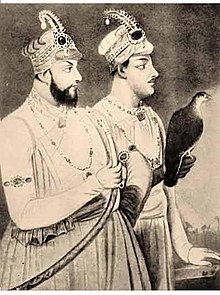Mir Ja'afar
| Mir Jafar | |||||
|---|---|---|---|---|---|
|
Nawab of Bengal, Bihar and Orissa (Nawab of Bengal) Shuja ul-Mulk (Hero of the country) Hashim ud-Daulah (Sword of the state) Ja'afar 'Ali Khan Bahadur Mahabat Jang (Horror in War) |
|||||

Mir Jafar (left) and his eldest son, Mir Miran (right).
|
|||||
| Reign |
2 June 1757 – 20 October 1760 25 July 1763 – 17 January 1765 |
||||
| Predecessor | Siraj ud-Daulah | ||||
| Successor | Mir Qasim (after 1760) and Najimuddin Ali Khan (after 1765) | ||||
| Born | 1691 | ||||
| Died | 17 January 1765 (aged 74) | ||||
| Burial | Jafarganj Cemetery, Murshidabad | ||||
| Wives |
|
||||
| Issue |
Sadiq Ali Khan Bahadur (Mir Miran) |
||||
|
|||||
| Dynasty | Najafi | ||||
| Father | Sayyid Ahmed Najafi (Mirza Mirak) | ||||
| Religion | Islam | ||||
| Full name | |
|---|---|
| Mir Jafar Ali Khan Bahadaur |
2 June 1757 – 20 October 1760
Sadiq Ali Khan Bahadur (Mir Miran)
Najimuddin Ali Khan Bahadur
Najabut Ali Khan Bahadur (Mir Phulwari)
Ashraf Ali Khan Bahadur
Mubaraq Ali Khan Bahadur
Hadi Ali Khan Bahadur
Fatima Begum Sahiba
Misri Begum
Roshan-un-nisa Begum Sahiba (Nishani Begum)
Mir Jafar Ali Khan Bahadur (c. 1691–5 February 1765) was the first Nawab of Bengal with support from the British East India Company. He was the second son of Sayyid Ahmad Najafi. His rule is widely considered the start of British imperialism in India and was a key step in the eventual British domination of vast areas of the subcontinent. Siraj ud-Daulah, the previous Nawab of Bengal along with his army were defeated and killed in the Battle of Plassey by the British due to the betrayal of the commander of Siraj ud-Daulah′s army, Mir Jafar, who betrayed Siraj ud-Daulah to become the next Nawab. Thus after helping the British defeat Siraj ud-Daulah he became the new Nawab of Bengal in 1757 with military support from the British East India Company as a reward for his betrayal. However, Jafar failed to satisfy constant British demands for money. In 1758, Robert Clive discovered that through his agent Khoja Wajid, Jafar had made a treaty with the Dutch at Chinsurah. Dutch ships of war were also seen in the River Hooghly. Circumstances led to the Battle of Chinsurah. British company official Henry Vansittart proposed that since Jafar was unable to cope with the difficulties, Mir Qasim, Jafar's son-in-law, should act as Deputy Subahdar. In October 1760, the company forced him to abdicate in favor of Qasim. However, Qasim's independent spirit and plan to force the East India company out of his dominion led to his overthrow, and Jafar was restored as the Nawab in 1763 with the support of the company. Mir Qasim however refused to accept this and went to war against the company. Jafar ruled until his death on 17 January 1765 and lies buried at the Jafarganj Cemetery in Murshidabad, West Bengal, India.
...
Wikipedia
